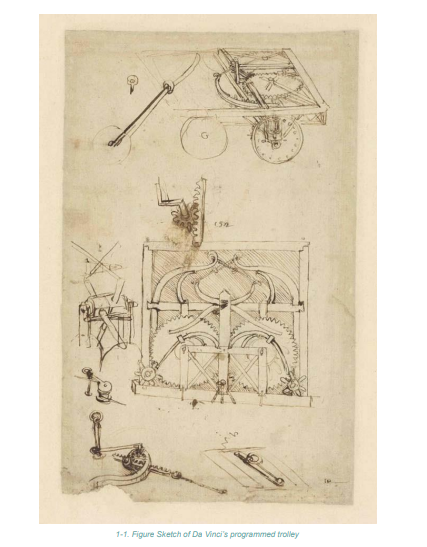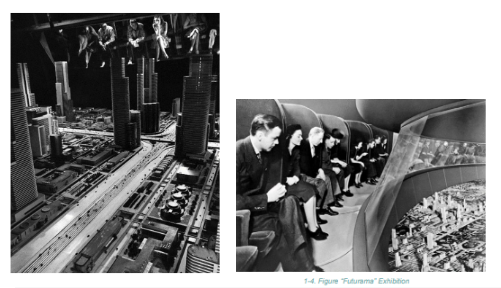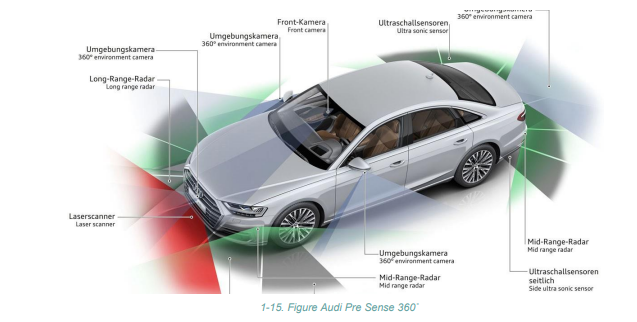Lesson 1: AUTONOMOUS VEHICLE HISTORY
In this lesson, we will delve into the fascinating history of autonomous vehicles, from their early beginnings to the promising future they hold.
- Beginnings
- The history of autonomous vehicles is an ongoing journey with no clear end in sight.
- The idea of autonomous vehicles traces back to the genius of Leonardo da Vinci in 1478 when he sketched a programmed trolley.
- Da Vinci’s concept featured a mechanism similar to clockwork, designed to travel along a predetermined path.
- This visionary sketch can be considered the inception of the autonomous vehicle concept.
- However, da Vinci’s trolley, like modern autonomous vehicles, built upon the inventions of earlier generations. Ancient Greece, for instance, contributed foundational ideas, including Heron’s automated puppet show, resembling an early form of an “autopilot.”

- Years of Daydreaming
- The following five decades saw sporadic attempts at creating autonomous vehicles, mainly as conceptual designs.
- In 1939, General Motors sponsored an exhibition called “Futurama,” which showcased the vision of a future city with electric vehicles controlled by radio waves.
- General Motors also presented prototypes of autonomous vehicles called Firebird in the 1950s and 1960s.
- In 1958, RCA and General Motors experimented with vehicles equipped with radio receivers and actuators, which could be controlled by radio signals.
- The 1960s saw the UK Traffic and Road Testing Laboratory testing the Citroen DS, operated using cables embedded in the road.
- The early 1970s held promise for autonomous vehicles, with predictions of road improvements and safety benefits.
- However, funding for these projects dwindled in the mid-1970s.

- Dream Becomes a Reality
- In 1977, Japan’s Tsukuba laboratory introduced the first computerized autonomous vehicle capable of following road markings.
- The 1980s witnessed significant progress. Ernst Dickmanns and his team developed the VaMoRs in 1986, an autonomous vehicle based on camera data.
- In 1989, Carnegie Mellon University pioneered the use of artificial neural networks in autonomous vehicles.
- The 1990s saw the “No Hands Across America” venture, with Carnegie Mellon University’s Navlab completing a 5,000 km journey.
- Professor Alberto Broggi’s ARGO project in 1996 modified a Lancia Thema to follow road lines autonomously.
- In 2004, DARPA organized the Grand Challenge, spurring innovation in autonomous vehicles.
- Notably, autonomous dump trucks by Komatsu began testing in 2008.
- The SARTRE project (2009-2012) aimed to create road trains with passenger vehicles following a professional driver’s lead.

- Present
- Modern driver assistance systems in serially manufactured vehicles have brought us closer to fully autonomous vehicles.
- These systems include collision prevention, driver monitoring, recognition of traffic signs, adaptive lights, blind spot monitoring, lane departure prevention, parking assistance, and active suspension.
- Manufacturers like Nissan, Mercedes-Benz, Tesla, Volvo, Toyota, and Volkswagen are actively developing autonomous vehicles.
- Google’s Waymo project, which started in 2009, is one of the most well-known autonomous vehicle initiatives.
- These efforts are striving to make autonomous vehicles a common sight on our roads.
- A significant milestone was Diamler and the Karlsruhe Institute of Technology’s autonomous drive in 2013, when a vehicle independently traveled the same route that Bertha Benz had taken 125 years earlier, marking the first long-distance car journey in history.

Conclusion
- The history of autonomous vehicles is rich with innovation, from da Vinci’s sketches to modern self-driving technology.
- While the journey continues, the past demonstrates the human drive to explore autonomous transportation.
- With ongoing advancements in technology, we are inching closer to the day when autonomous vehicles become a commonplace reality on our roads.